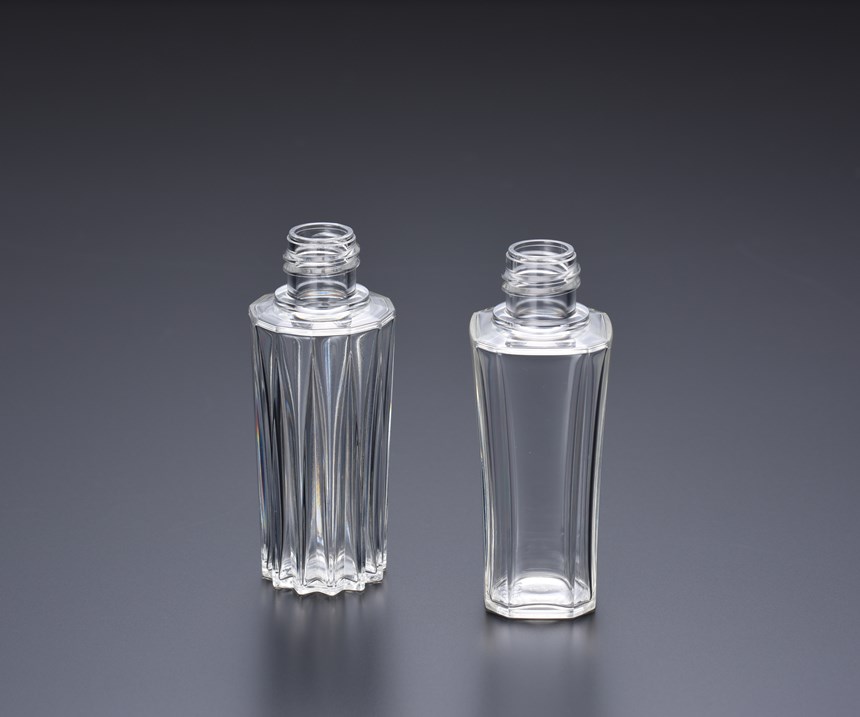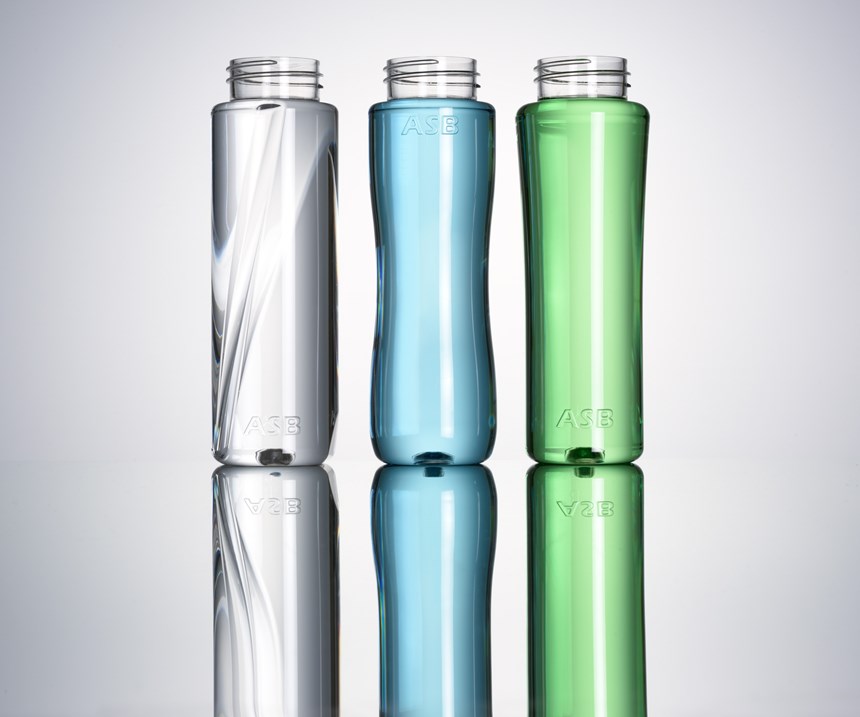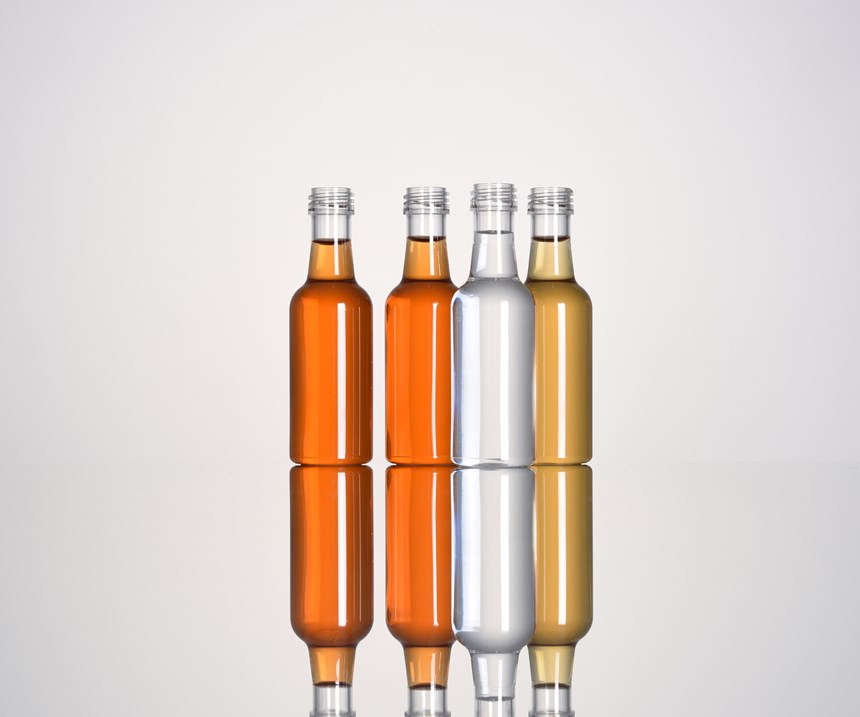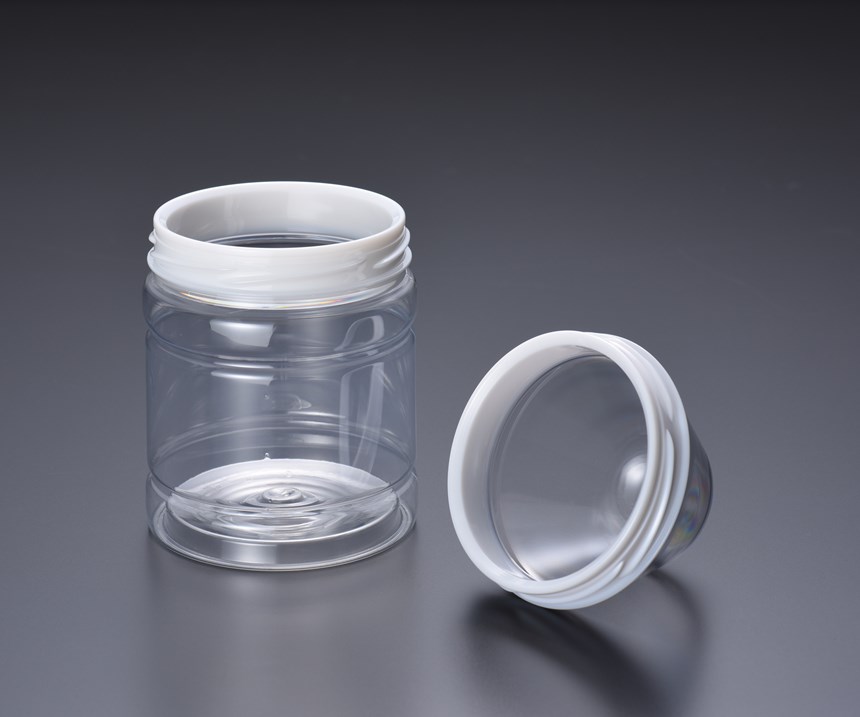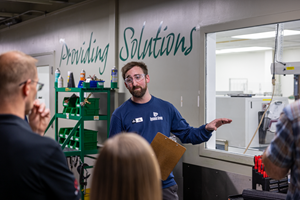Blow Molding: Wide-Ranging PET Technologies for Higher Productivity & Specialty Products
Nissei ASB brings one- and two-stage stretch-blow machines for beer bottles, airline liquor miniatures, sports bottles, premium cosmetics, and wide-mouth jars.
In its largest NPE booth ever, Nissei ASB Machine Co. (U.S. office in Smyrna, Ga.) will bring five stretch-blow machines to Orlando, demonstrating a number of upgrades and special options that enhance productivity and allow production of a wide range of specialty PT containers from beer bottles, airline liquor miniatures, and sports drinks to premium cosmetics and wide-mouth jars. Integration with Industry 4.0 or the Internet of Things (IoT) is also on display.
• ASB-12M v2: NPE will see the launch of a revised version of this one-step machine that adds a new control system based on Industry 4.0 standards for factory integration. This servo-hydraulic machine will be molding a four-cavity, 40-ml premium-quality, thick-walled cosmetic container in a family mold with two different designs.With a weight over 31 g, the resulting 2-mm wall thickness simulates the high-grade appeal of glass. But most notable, according to the company, is the short cycle time of 13.4 sec, vs. a typical 40+ sec for such a heavyweight container.
Normally, molding such a thick container on such a fast cycle would require use of specialized or expensive resins to avoid haziness from crystallization. Instead, Nissei ASB takes full advantage of the preform conditioning station in these four-station machines to modify the preform’s temperature profile, shape and thickness prior to its transfer to the blow station. Dry-cycle time of the machine has also been shortened by the next-generation computer control, which is said to offer faster response. The control also features a larger PC-based touchscreen, an interface that the company plans to standardize across its model range to simplify training. Major machine functions can be added or updated via software installation only, the company says.
This machine molds containers from 5 ml to 2.5 L. Cavitation ranges from 15-mm neck-diam. eyedrop bottles in eight cavities to 83-mm jars in a single cavity. The model at the show has an optional long-stroke injection unit that provides a 50% increase in available shot size, suitable for thick cosmetic bottles.
• ASB70DPH v4: This medium-sized, four-station, one-stage machine (one of ASB’s best sellers) will utilize a set of options that extend its versatility. These include an energy-saving servo-hydraulic system, 78% increased shot capacity with optional IU-50 injection unit (useful for large or thick PET containers or non-PET resins with lower densities; and extended daylight on the injection clamp for molding longer preforms (especially useful for non-PET resins, whose optimum stretch ratios differ from those of PET).
At NPE, this machine will mold a 700-ml reusable sports bottle in Eastman’s Tritan copolyester. The 90-g bottle will be molded in four cavities in 14.4 sec. ASB says the excellent clarity of this resin is “only achievable with the one-step molding process.”
• ASB-150DPX: This servo-hydraulic machine is said to the “world’s first triple-row, one-step injection stretch-blow machine.” Making its debut in the Americas, this machine is designed for high outputs of small PET bottles. The ASB-150DP is already available withe single and double rows; the third row allows production of small bottles in 24, 36 or 48 cavities. At NPE, it will mold 50-ml, 10.5-g airline liquor miniatures in what ASB says is an “unprecedented” 48 cavities with a cycle time of 8.6 sec, for output greater than 20,000 bph.
The container design requires a very small preform that ASB says would “impossible to handle and reheat in a two-step system.” The company also notes that this triple-row machine has upgraded hydraulics and an optimized clamp stroke for faster injection clamping; and the blow-air circuit is optimized for small-bottle production, reducing air consumption by more than 50% vs. standard systems. Although these features were developed specifically for this machine, many of them are also planned for future updates of other models.
ASB says this machine has already generated strong interest in the dairy sector for products like flavored milk and yogurt-based drinks in 36 cavities. In a 24-cavity configuration, the machine can mold round or oval containers up to 300 ml with a 38-mm neck, which suits it to single-serving juice or water bottles.
• HSB-2M/6: This is a new model in a series of two-step, reheat machines with ASB’s double-blow heat-setting process. With fully electric clamping, this model can mold 1 L jars with thread diam. up to 86 mm in six cavities. It is aimed at hot-fillable and pasteurizable foods like pickles, jams, and sauces. The double-blow process is said to achieve the practical maximum heat resistance for PET of about 95 C (203 F). At NPE, it will mold six 500-ml jars with 80-mm neck in a 4.5-sec cycle (4800 bph). The neck is suitable for a metal, twist-off lug closure designed for filling at 88 C (190.4 F). The jar is designed for a filling requirement of cheese sauces: filling at 88 C, tunnel showering to maintain at least 72 C for 19 min; controlled cooling to below 30 C over a period of 35 min.
• HSB-6N: This machine is for double-blow reheat stretch-blow molding of heat-resistant bottles with neck diam. up to 38 mm. Necks can be amorphous or crystallized. With fully electric clamping, this machine will demonstrate molding 650-ml beer bottles in six cavities and a 4.5-sec cycle (4800 bph). The bottles are designed to withstand tunnel pasteurization at 65 C (149 F) for 15 min.
Related Content
How to Extrusion Blow Mold PHA/PLA Blends
You need to pay attention to the inherent characteristics of biopolymers PHA/PLA materials when setting process parameters to realize better and more consistent outcomes.
Read MoreMedical Molder, Moldmaker Embraces Continuous Improvement
True to the adjective in its name, Dynamic Group has been characterized by constant change, activity and progress over its nearly five decades as a medical molder and moldmaker.
Read MoreFormulating LLDPE/LDPE Blends For Abuse–Resistant Blown Film
A new study shows how the type and amount of LDPE in blends with LLDPE affect the processing and strength/toughness properties of blown film. Data are shown for both LDPE-rich and LLDPE-rich blends.
Read MoreWisconsin Firms Unite in Battle Against Covid
Teel Plastics opened new plant in record time, partnering with AEC & Aqua Poly Equipment Co. to expand production of swab sticks to fight pandemic.
Read MoreRead Next
Advanced Recycling: Beyond Pyrolysis
Consumer-product brand owners increasingly see advanced chemical recycling as a necessary complement to mechanical recycling if they are to meet ambitious goals for a circular economy in the next decade. Dozens of technology providers are developing new technologies to overcome the limitations of existing pyrolysis methods and to commercialize various alternative approaches to chemical recycling of plastics.
Read MoreWhy (and What) You Need to Dry
Other than polyolefins, almost every other polymer exhibits some level of polarity and therefore can absorb a certain amount of moisture from the atmosphere. Here’s a look at some of these materials, and what needs to be done to dry them.
Read More


